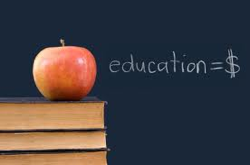Counting the costs
A key factor for many parents in selecting the education method for children is cost. Today, many families have dual incomes in order to meet the costs of living. While it is not the place of this paper to examine the reasons and motives for a dual income, we can assume that in some cases it is necessary. In these cases the time of the couple is at a premium as much of their day is taken with work, which may preclude home schooling, and if finances are finely balanced it may also exclude private schooling. In this case the parents have little choice but to make the best of the situation they are in and spend as much time with their children as they can. This is difficult however, and frequently dual income families struggle to not only spend time with children but also struggle to prioritize time for Mum and Dad to be together and have a meaningful relationship.
Regardless of financial circumstances, a dominant reason to select public education is cost. Part of the value proposition of public education is that it is available for all, regardless of economic conditions. This makes it an easy choice for parents who rely on two incomes to keep up with the cost of living, or where the family simply doesn’t have the financial capacity for private education.
However, there are costs hidden in public schooling. Parents are responsible for paying for school uniforms and stationery requirements and are increasingly asked to pay for field trips, special fund raising lunches (especially as school funding is cut back), sports days and a variety of other events and items that seem to continually come up on what seems like an almost daily basis. So before considering public schooling as completely free, ensure that you take into account the hidden costs. In many schools these hidden costs amount to more than $1000 per year[i]. These hidden costs can often help to offset the price of private schooling.
Private Christian schools charge school fees, but at some schools these fees cover everything the student does at school including field trips and stationery. There may still be fund raising events throughout the year, but depending on the school and the fees, these vary. However, Private Christian schools are almost always more expensive than public schools, but not necessarily by much depending on the school.
If you are considering two schools, one private and one public, be sure to ask about the additional costs (or events) parents are often asked to pay for during the year. Regardless of whether these are optional or not, pressure is applied both by the student and the school to be included, so regard them as part of the cost structure. This allows for a fairer and more comprehensive comparison than a comparison of fees.
If dual incomes are not mandatory, it may be possible if desired for Mum to stay home and manage the responsibilities of teaching their children. Homeschooling does cost money and tends to be at least as expensive as public schooling, but not necessarily much more so. You still pay for stationery, but the hidden costs tend to evaporate and you get to plan what you spend on educational field trips rather than someone dictating it to you. Home schooling costs primarily include curriculum, co-operative costs (if you sign up to a homeschool co-operative) and field trips (which of course you control and plan yourself).
If you are considering home schooling, find out if there are any financial support options available through the state or local government. Some locations have funding schemes to assist with home schooling parents to reduce the net cost to parents of educating their children. For example in New Zealand, the government will reallocate the funds for the child’s public education to the parents in the case that they are home schooled. For these (and perhaps other reasons) in many cases, it is more cost effective to home school than to send children to a public school.
Regardless of what schooling option you select, schooling will always cost money. The question is what are you getting for the money and how does it align with your goals as parents?
[i] When we had children in public schools we worked out one year that we were paying well over $1000 per year in hidden costs without factoring in a uniform for public education at a run of the mill public school.
